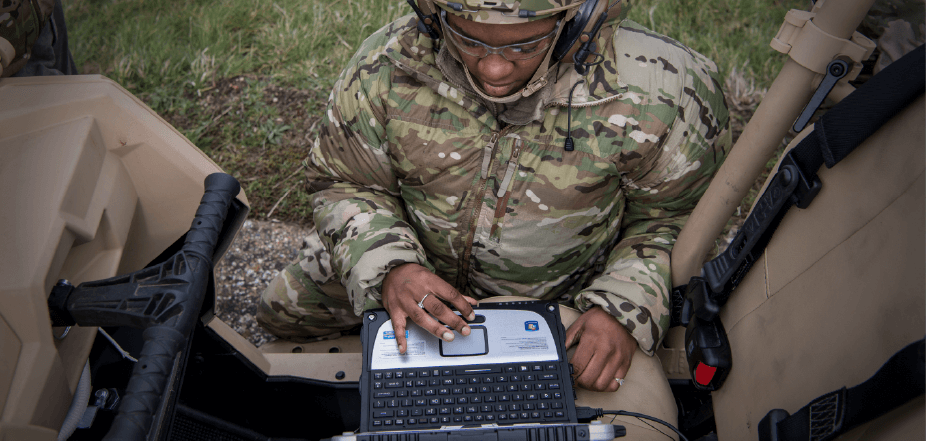Having the right information in the right place at the right time has long been the key to success on and off the battlefield. With the transition to a “digital force,” exponential rates of data production and consumption offer the opportunity for a defense agency to execute operations faster with greater speed and accuracy than any other point in history.
Delivering on that opportunity means finding more efficient and secure approaches for collecting and disseminating the data intelligently and securely during warfare and humanitarian missions. Adding to the issue are tactical environments where buying more gear, increasing bandwidth, or adding more people is not a realistic course of action.
As a DoD veteran with over 23 years of service, I’ve seen firsthand the challenges that exist in tactical data operations. The emergence of new data management technologies has created five key areas that should be focused on to improve overall tactical data operations. In this blog, I explain the challenges I’ve witnessed, explain the five key areas, and share how Cohesity can help defense agencies address them.
Today’s tactical data operations challenges
Although the development of data technology has exploded, the type that processes growing information flows lags behind the type that produces it. This capability mismatch between inputs—full motion video, positioning data, collection sensors—and outputs—intelligence estimates, mission orders, target lists—is drowning tactical military organizations in waves of data. This situation promotes increased error and indecision and also requires a seemingly endless investment in hardware and resources.
In field operations, organizations have traditionally taken days or weeks to install and configure a multitude of applications and services as part of server architectures for mobilizing data to tactical-edge deployments. Not only have these installations and configurations slowed initial deployment, but they lack the agility required by tactical teams.
Differing operator skill sets make consistent data protection challenging, and when infrastructure breaks, units lose valuable time and risk mission success rebuilding systems from scratch in the most austere environments. Making everything even more difficult is the reality that conflict often occurs in these data-denied areas, making it near-impossible for these systems to reliably access the information defense agencies want or don’t yet know they need.
To turn these challenges into opportunities requires a solution or service that focuses on five key areas.
Tactical data infrastructure
Tactical operations are dynamic by their very nature. DoD data operations and management platforms must mirror that dynamic requirement. During deployment, systems will have periods of reach-back, but that may not always be consistent. Regardless of connectivity, local data must be managed and secure and when possible deconflicted with strategic sources.
The Cohesity ecosystem can help meet the challenge of austere environment data management and apply the right technologies to ensure mission success by collecting, anonymizing, aggregating, and analyzing metadata globally and providing recommendations to data managers. A global dashboard for visibility and multi-cluster, multi-workload management give operators a summary of network health and geo-located data accessibility. Global search enables admins and consumers to access critical operational data at the edge, in core data centers, and in the cloud while global reporting delivers insights and intelligence.
Data and application mobility
Tactical operations depend on keeping critical data and applications updated and positioned where needed. This functionality is crucial for a unit to maintain continuity of operations in a constantly evolving operation. You must implement technology that helps ensure data and application interoperability, security risk and mitigation and data migration. For example, the U.S. Army has the vision of a cross domain, data, and application “fabric” from the cloud to the data center to the tactical edge. The concept is that data and applications move freely across nodes participating in the mesh.
Cohesity brings a wealth of data mobility experience and technology to the DoD enterprise. Key highlights are a single UI designed to maximize interoperability and heterogeneity by running the same software-defined data management tools on a variety of infrastructures (physical, virtual, or cloud), along with a data replication engine, a cloning engine, and “any to any” capability. Cohesity’s revolutionary hybrid data and application fabric introduces a new and improved system for moving mission critical data from the tactical edge to the core to the cloud, and application mobility is a critical component of Cohesity’s data management platform. And Cohesity can enable a highly scalable filestore at each node in the network so DoD and tactical teams can expand storage capacity and storage access protocols at the edge.
Operations management
Defense agencies’ data operations require a core set of data management networking tools and an extension of the capabilities of a large, powerful collection of nodes. Data operations need to ensure healthy day-to-day operations of the data sharing system, while providing insights into organic system growth. Global management mechanisms are needed to aggregate and execute DoD missions across all echelons.
Cohesity can help defense agencies overcome challenges like inefficient data operations, lack of visibility, and control and resource demands by consolidating fragmented workloads and data silos onto a hybrid data and application platform. Cohesity’s unprecedented global insight into previously dark and siloed data protection operations reduces hidden risks, and its instant aggregated global reporting alleviates the DoD challenge of unreliable and slow data assessments.
Tactical data protection
Data security is paramount in defense. Hostile forces need to be denied access to data. Protection also requires the ability to back up and restore. Because the tactical theater is notorious for limited data connectivity between locations, tactical data protection is a challenge. In fact, it can often become a secondary or lower priority, especially during a mission. Cohesity helps ensure that defense agencies do not have to compromise between security and operational efficiency. Security is a core tenant of our management platforms, and our technology can inherently protect data in harsh and hostile environments.
Cohesity’s hyperconverged architecture uses software-defined techniques to scale systems (up and down) to fit modern technologies into existing kit security requirements. State-of-the-art deduplication and compression create logical storage capabilities far beyond the traditional storage capacities. Global visibility of data gives field and HQ personnel the ability to easily move data to and from areas of responsibility (AORs) on demand. In addition, Cohesity provides a comprehensive data security architecture that includes immutable backups, AI-based early detection, and the ability to rapidly recover at scale. This architecture not only handles traditional, legacy data, VMs, and applications but also solves the protection challenge of modern workloads like NoSQL and Kubernetes.
Edge computing
Using machine-based insights, DoD is improving outcomes in both peacetime and combat situations. However, artificial intelligence (AI) and machine learning (ML) in the field is very challenging given the space, cooling, and weight restrictions of tactical data centers, not to mention limited connectivity. Today when tactical kits are disconnected from cloud and garrison-based data center resources, the power of big data analytics is unavailable, leaving commanders with limited actionable insights from higher echelons. The reverse is also true. If data and compute power at each tactical site make up a small, enclosed pool, they are not part of the overall data operations providing higher ups with insights only the tactical team can provide. Both the data and compute resources are effectively “dark” and orphaned, which provides virtually no help for finding insights.
Cohesity is a cloud and compute-agnostic platform, so it can be deployed on many existing tactical assemblies. For data analytics, it can create a smart data fabric that gives decision-makers concise, curated data and even some completed analysis. The architecture includes a robust Kubernetes-based application framework. Using this framework, which can be deployed for even the smallest form factor, the architecture can distribute AI/ML algorithms to the field, and Kubernetes apps can extrapolate AI/ML insights from the pools of data collected in tactical settings. Distributed pre-processing push compute to the data storage architecture, and DoD systems can accelerate time to results with data analytics.
Interested in learning more?
To learn more about the Cohesity Helios multicloud data platform click here. You can also sign up for a free trial, or contact us for more details.


















